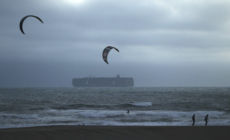-
Reno Shooting Shatters Lives at a Bachelor Party - 30 mins ago
-
Hiker in Yosemite sequoia grove killed by falling tree branch - 40 mins ago
-
Tsunami Live Tracker as 10 Foot Waves Could Hit Hawaii - 43 mins ago
-
Tsunami Warning Issued for Northern California - about 1 hour ago
-
How to Watch Pachuca vs San Diego FC: Live Stream Leagues Cup, TV Channel - about 1 hour ago
-
Along California coast, waiting for tsunami waves with concern, curiosity, comedy - about 1 hour ago
-
Senate Democrats Go to Battle Against Each Other - 2 hours ago
-
Thailand and Cambodia Stepped Back From War, but Their Temple Fight Remains - 2 hours ago
-
As EPA reverses key climate policy, California could lead a resistance - 2 hours ago
-
LeBron James, Nuggets Rumors Get Bold Update - 2 hours ago
China Warns US Ally With Show of Force
China asserted its sovereignty over a disputed reef in the contested South China Sea by conducting military and coast guard patrols on Saturday—a claim the Philippines denied.
Newsweek has emailed both the Chinese and Philippine militaries for further comment.
Why It Matters
China has claimed sovereignty over most of the South China Sea, overlapping the territorial claims of other regional countries—including the Philippines, a mutual defense treaty ally of the United States—and often leading to standoffs and clashes between their maritime forces.
The Chinese patrols were conducted around Huangyan Dao [Island], a fishing ground known in the Philippines as Bajo de Masinloc. The reef, under China’s control since 2012, lies closer to the Philippines’ Luzon Island than to the nearest Chinese island province, Hainan.
While the South China Sea reef lies within Manila’s internationally recognized 230-mile-wide exclusive economic zone, Beijing asserted jurisdiction over the surrounding waters by releasing a list of 16 base points connected by straight baselines in November 2024.
What To Know
In a statement released on Saturday, the Chinese People’s Liberation Army Southern Theater Command announced that it had conducted what it called “combat readiness patrols” in the Chinese territorial waters and airspace around Huangyan Dao and its surrounding areas.
The Chinese military command, which is oriented toward the South China Sea, claimed that its assigned air and naval forces have been “continuously” strengthening patrols around the reef to further bolster “relevant maritime and airspace control and management” since May.
The China Coast Guard also claimed on Saturday that it had conducted “law enforcement patrols” near Huangyan Dao. China operates the world’s largest maritime law enforcement fleet, with over 150 vessels each weighing more than 1,000 tons, according to the Pentagon.
During its intensified patrols around the reef last month, the China Coast Guard conducted what it called “tracking, warning, intercepting, and driving away operations” in accordance with China’s laws and regulations to strengthen its management and control of the area.

Ezra Acayan/Getty Images
Rear Admiral Roy Vincent Trinidad, spokesperson for the Philippine Navy, said no Chinese combat readiness patrols were observed around the reef or within the Philippine exclusive economic zone in the West Philippine Sea, newspaper Manila Standard reported on Sunday.
The Philippines refers to the portion of the South China Sea within its exclusive economic zone as the West Philippine Sea. However, the Chinese government maintains that “South China Sea” is the common geographical name accepted by countries around the world.
The Philippine spokesperson revealed that, as of Saturday morning local time, two Chinese coast guard ships and six Chinese maritime militia vessels were spotted at the reef, along with four Vietnamese fishing boats and three Taiwanese vessels, according to the report.
What People Are Saying
The Chinese People’s Liberation Army Southern Theater Command said: “The move [patrol] is aimed at resolutely safeguarding China’s sovereignty and security, as well as upholding peace and stability in the South China Sea region.”
The China Coast Guard said: “The operation aims to firmly safeguard China’s territorial sovereignty and maritime rights and interests.”
Rear Admiral Roy Vincent Trinidad, spokesperson for the Philippine Navy, said: “No activity of PLA-N [People’s Liberation Army Navy] was monitored. News like these are all part of information shaping operations by the [Chinese] Communist Party to address any internal dissent or shape the international discourse to their favor.”
What Happens Next
The Philippines is likely to conduct further exercises in the South China Sea with the U.S. and other allies to counter China’s military and coast guard presence in the disputed region.
Source link


















